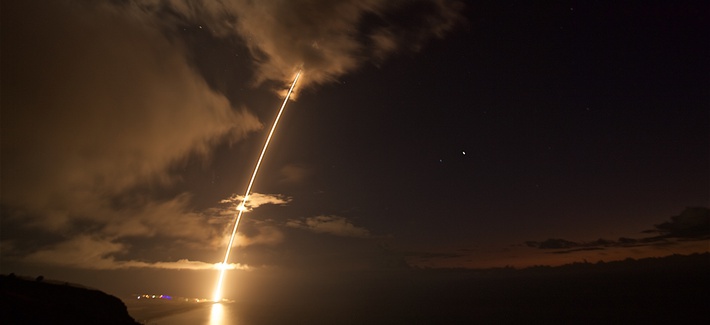What about our long-range defenses, the Ground-Based Midcourse Defense, or GMD, interceptors based in Alaska and California? There the test record is even worse. Even under ideal conditions, where the defenders knew the time, direction and trajectory of the test target and all the details of its shape, temperature, etc., this system has only hit its target half of the time.
“The success rate of the GMD systems in flight intercept tests has been dismal,” says former director of operational testing for the Pentagon, Philip Coyle. Our chances of intercepting a threat missile, even under ideal conditions, are basically “as good as a coin toss,” admits the former head of the Missile Defense Agency, retired Lt. Gen. Trey Obering.
Yet, reporters routinely use words like “shield” and “dome” to describe our supposed capability, giving us a false sense of security. Officials make the matter worse with exaggerated, if carefully constructed, claims. “The United States military can defend against a limited North Korea attack on Seoul, Japan and the United States,” said Chairman of the Joint Chiefs, General Joseph Dunford at the annual Aspen Security Forum in July.
Is this true? It depends what you mean by the word “limited.”
If North Korea cooperated and shot their new intercontinental ballistic missile, the Hwasong-14, at the United States with adequate warning so that we could prepare, and if the warhead looked pretty much like we expect it to look, and if they only shot one, and if they did not try to spoof the defense with decoys that looked like the warhead, or block the defense with low-power jammers, or hide the warhead in a cloud of chaff, or blind the defense by attacking the vulnerable radars, then, maybe this is true. The United States might have a 50-50 chance of hitting such a missile. If we had time to fire four or five interceptors, then the odds could go up.
But North Korea is unlikely to cooperate. It will do everything possible to suppress the defenses. The 1999 National Intelligence Estimate of the Ballistic Threat to the United States noted that any country capable of testing a long-range ballistic missile would “rely initially on readily available technology – including separating RVs [reentry vehicles], spin-stabilized RVs, RV reorientation, radar absorbing material, booster fragmentation, low-power jammers, chaff, and simple (balloon) decoys – to develop penetration aids and countermeasures.”
Our anti-missile systems have never been realistically tested against any of these simple countermeasures. This is one reason that the Pentagon’s current director of operational testing is much more cautious in his assessments than missile defense program officials. “GMD has demonstrate a limited capability to defend the U.S. Homeland from small numbers of simple intermediate-range or intercontinental ballistic missile threats launched from North Korea or Iran,” he reports. Moreover, it is impossible, he says, to “quantitatively assess GMD performance due to lack of ground tests” and “the reliability and availability of the operational GBI’s [Ground-Based Interceptors] is low, and the MDA continues to discover new failure modes during testing.”







